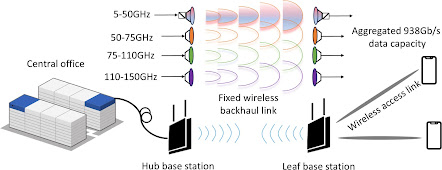TECH
![]()
New wireless technology reaches record 1 Tbps data transmission speed
By combining different wireless techniques, UK researchers achieved record-breaking data transmission speeds. The technology achieved 1 Tbps in lab experiments. Now, it only needs to prove itself in commercially viable applications.
A University College London (UCL) team achieved a nearly one terabit per second data transfer speed over a wireless connection. The world record feat opens the doors to future improvements to high-speed wireless. The researchers used a wide range of frequencies in the electromagnetic spectrum, achieving data rates thousands of times faster than typical UK download speeds over 5G networks.
The recently published study describes an ultra-wideband transmission over the air that combines electronic and photonic-assisted signal generation to send 938 Gbps over a 5-150GHz frequency range. The researchers point out that traditional wireless networks use radio frequencies operating below 6GHz, providing an average speed of 100 Megabits per second over 5G.
Radio frequencies are now congested with many disparate signals, which interfere with wireless communication speeds. The UCL team overcame this "bottleneck" by using radio and optical technologies, an unprecedented mix, providing much faster and more stable data transmission capabilities.
The researchers developed the novel solution by combining "advanced electronics," which perform better in the 5-50GHz range, and photonics technology that uses light to generate radio waves in the 50-150GHz range. They achieved a total bandwidth of more than five times higher than previous wireless transmission records (145GHz). The blistering speed is 9,380 times faster than the best average 5G network speeds in the UK. The ultra-wide transmission method transferred a two-hour UltraHD movie (14GB) in just 0.12 seconds. That amount of data takes 19 minutes over a 100 Mbps 5G connection.
"Current wireless communication systems are struggling to keep up with the increasing demand for high-speed data access, with capacity in the last few meters between the user and the fiber optic network holding us back," said Zhixin Liu, lead author of the UCL study.
So far, the team has only demonstrated the new technology in a lab under ideal conditions. However, they have already begun working on a prototype device to test it in commercial environments. Optimistically, a proper implementation of the novel transmission method could be ready for implementation in commercial equipment within three to five years.
The UCL team thinks its new technology could significantly improve wireless connections, closing the gap between ultra-fast fiber optic cables and "last-mile" devices such as smartphones or Wi-Fi clients. Mobile networks could benefit the most, providing faster and more stable connectivity to densely populated areas over 5G and even 6G services.


No comments:
Post a Comment